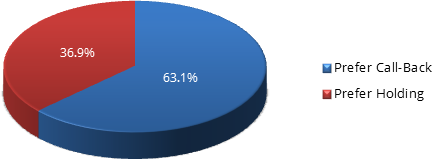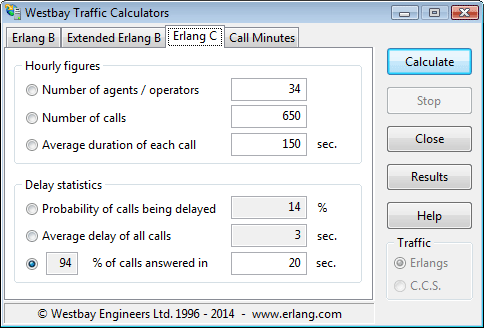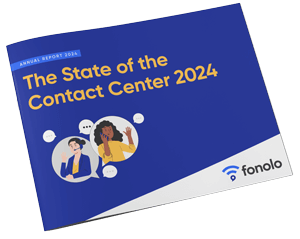Measuring and improving call center metrics can be a pain point for executives. Your call center operates in a stressful environment where good quality metrics lead to a higher standard of customer service.
This guide will help you improve six of the most important contact center metrics for better performance and future success.
Metric #1: Customer Satisfaction (C-Sat)
Definition of Customer Satisfaction:
Customer satisfaction can be defined as: “The level of satisfaction that customers have with an organization and its products or services.”
It’s why we’re all here.
Your customer satisfaction scores — or as they’re affectionately known: CSaT scores — indicate how well your agents are performing at their core task, solving customers’ problems.
They can be arrived at in a variety of ways, but are typically the result of simple customer surveys aimed at measuring sentiment. These should be sent out at the end of every customer interaction and ask for a simple rating of that interaction.
Regardless of how you arrive at your CSAT score, it’s one that should always be top of the list when looking at the effectiveness of your call center.
How to Improve Customer Satisfaction:
Your mission as a call center is to keep service costs low while maintaining high caller satisfaction. Here are three ways your contact center can keep this metric high:
1. Keep Your Employees Happy
Keeping employees cheerful depends on a number of factors including well-developed company culture, access to user-friendly and intuitive tools & technology, and ensuring that employees have a voice inside your organization. Ultimately, engaged employees will create satisfied customers.
2. Resolve Customer Calls the First Time
If you ask customers what frustrates them the most, nearly half (42%) will say, “having to speak with multiple agents and start over every time”.
“Customer satisfaction level depicts the organization’s performance and profitability” — Vipul Srivastav
Resolving customer issues the first time is the single biggest way to improve customer satisfaction. Studies reveal that caller satisfaction ratings will be 5-10% lower when a second call is made for the same issue.
3. Eliminate Hold Time and Use Call-Backs
Eliminating the need for customers to wait on hold not only increases customer satisfaction; it also reduces costs for call centers. Forcing callers to wait in queue drives up telco costs and, unfortunately, causes many of them to hang up and end the conversation before it even begins.
In fact, 60% of customers will abandon a call after just one minute of hold time. Instead, contact centers could offer callers the option to receive a call-back. In a recent poll, 63% of customers said they would prefer a call-back to waiting on hold.
Customer Preferences for Callback vs. Waiting on Hold

Metric #2: Service Level
Definition of Service Level:
Also called the telephone service factor (TSF). Service level is one of the oldest and most revered contact center metrics. It’s expressed as X percentage of contacts answered in Y seconds.
Service level is another classic call center KPI that doesn’t usually get a lot of attention; We think it will become increasingly important as contact centers transition to ‘Experience Hubs’.
It’s a crucial metric, particularly for inbound contact centers. It’s typically measured as the percentage of inquiries answered within a pre-specified amount of time. This was traditionally measuring the time taken to pick up a phone call, but in 2020 should be measured across all channels. Setting the service level for your call center should be done with care and attention to you and your team’s needs.
It’s important because it’s directly tied to customer service quality. It tells you how accessible you are to your customers, as well as how many agents are needed at any time. It will determine your call center’s ability to handle call volume fluctuations and is directly tied to your customer satisfaction level.
After all, if there’s one thing we know everyone hates, it’s being kept waiting on the phone.
How to Improve Service Level:
In the past, call centers would try and hit the apparently important ’80/20′ service level, but this is no longer the best way to approach improving this call center metric.
Your target service level should be based on what your call center can reasonably achieve, given your staffing level and the expected call volume. So let’s say you have assembled the necessary data, how exactly do you get from staffing numbers and call volume numbers to service level numbers? The answer is with the lost art of Erlang, used to determine the number of agents required to staff a call center, given a desired call volume and probability of queuing.
Many call center managers working today don’t have that feel for capacity scheduling that one can only get by working directly with an Erlang tool. Fortunately, there are many easy (and free) ways to get back that feel. For example, you can experiment with an online Erlang C calculator. Another option is the Excel macro you can download here.

Remember, you can’t fix what you don’t measure. Armed with this tool you can begin to understand the impact of the variables on your organization, and then use it to maximize and improve the results from the ground up. Another way to improve your service level is with a call-back option, as you can use it to smooth out spikes in call volume, diverting calls to off-peak periods when you can handle the load more readily.
Metric #3: FCR First-Call Resolution
Definition of First-Call Resolution:
This is the percentage of calls that don’t require any further agents to address the customer’s reason for calling. The customer does not need to contact the organization again, nor does anyone within the contact center need to follow up.
First call resolution rate (FCR) is an old friend of the call center manager. The best way of winning consumer loyalty is by resolving their problem as quickly as possible.
“According to SQM Group, only 3% of customers who have a problem solved during the first service interaction are likely to churn. Compare that to the 38% of customers who are likely to churn if the issue isn’t resolved after the first call.” – Clint Fontanella
Let’s say a call center gets 100,000 calls per month. If the cost per call is $10, and 30% of calls are repeat calls, the cost of the repeat calls is $300,000 per month. A mere 10% reduction would yield a savings of $30,000 per month or $360,000 per year. Make the cost of a call $25, and the annual savings would be $900,000.
The industry standard for FCR is 70-75%. How does yours measure up?
How to Improve First-Call Resolution:
Unfortunately, there’s no silver bullet to improving this metric. You need to focus on three areas: people, process, and product.
In order to speed call resolution rates, be sure your agents have good listening skills, are focused on solving the right problem, and employ top-notch troubleshooting skills. They need to sound confident, anticipate related questions that callers might have, and follow-through on the commitments they make to the customer.
Sit with agents and watch them handle calls. They need to have information at their fingertips if they’re going to resolve issues on the first call. That could be as simple as a binder with procedures in it or as complex as an online knowledgebase.
Are you having quality issues? Is something continuing to fail time and time again? Are people calling back about the same failure issue? If so, what can you do to fix it?
Listen to the types of complaints that are driving repeat calls and examine your people, processes, and product to see what you can do to improve first call resolution.
Metric #4: Employee or Agent Satisfaction (E-Sat)
Definition Employee Satisfaction:
This metric is used to describe whether employees are happy and fulfilling their desires and needs at work.
There is no question that the way employees feel influences how they treat the customers they interact with.
“A brand is defined by the customer’s experience. The experience is delivered by the employees.”
— Shep Hyken
It’s no surprise then that the organizations providing the best customer experience are also leading the way in their employee engagement ratings.
Measuring your agent satisfaction — not just agent turnover — is as important a metric as customer satisfaction.
How to Improve Employee Satisfaction:
It’s no use measuring retrospectively, once disengaged agents have left the organization. Call center managers should be proactively working to stop employees disengaging and, ultimately becoming another turnover statistic.
In the last couple of years, we’ve seen more and more service decision leaders look to agent satisfaction as an indirect way to improve customer satisfaction rates — and we hope to see a lot more of this.
It’s no surprise that keeping call center agents engaged can be a real challenge, given the repetitive nature of the job (answering an endless stream of phone calls) and the metrics-based approach used to track performance.
Happy employees also mean a lower percentage of agent churn. High turnover results in inflated call center costs and a loss of qualified agents.
Here are some simple changes that you can easily implement to help improve agent satisfaction:
- Perform employee satisfaction surveys
- Provide career development pathways
- Deliver a well-balanced benefits plans
- Recognize employees for a job well done
- Provide a good work-life balance
Metric #5: Average Handle Time (AHT)
Definition Average Handle Time:
The sum of average talk time plus average after-call work for a specific time period.
How to Improve Average Handle Time:
Average Handle Time is one of the most abused call center metrics. Here are the top 5 methods to help your call center improve AHT.
1. Coach Your Agents in Multiple Skillsets
Effective coaching ensures that the skills, techniques and methods taught during training are practiced and applied during actual customer interactions.
2. Use Skills-Based Routing to Optimize Your IVR
Route the call based on the skills of the most qualified agent.
3. Learn to Anticipate Customer Questions
Train your agents to anticipate questions and provide the information before the customer asks.
4. Automate Call Center Tasks Whenever You Can
Do what you can to make things easy for the agent. Streamline processes and applications for easy navigation.
5. Give Your Agents the Right Resources
Whether it’s with well-written workflows, floor walks or the buddy-up agent approach, always aim to help the agent.
Metric #6: Abandonment Rate
Definition of Abandonment Rate:
The number of callers that hang up before reaching an agent.
How to Improve Abandonment Rate:
Why is the abandonment rate important? It speaks directly to customer dissatisfaction and the negative impact it has on customer loyalty. A high call abandonment rate is a sure sign of caller frustration.
Luckily reducing your abandon rates is proven to provide improved customer satisfaction and a better call center experience.
1. Keep the Caller Informed
If hold-times are an issue, consider preparing customers by placing a message in the IVR or ACD informing them of the estimated wait time. This reduces customer’s apprehension and will subsequently lower their desire to abandon the call.
2. Know Your Numbers
Call detail reports provide you with a wealth of information and insight into your calls. By knowing who abandoned a call, when they called you, and how long they waited before hanging up, you can make informed decisions on how to resolve the situation.
3. Employ a Call-Back Solution
Call-back technology — otherwise known as “virtual queuing”, or “replacing hold-time with a call-back” — can improve the customer experience, reduce cost-per-call and lower the abandonment rate in your contact center.
Customer Satisfaction Rules the Roost
No doubt as AI spreads to call centers far and wide, new KPIs and analytic tactics for the contact center will emerge.
But the success of the contact center today — and the Experience Hub of the future — hinges on the same thing as it always has: customer satisfaction.
All other KPIs for your call center should be designed to help improve that Mother-of-all-Metrics; The three other metrics discussed here all contribute to greater customer satisfaction in one shape or form.
Together, these four should give you, or your new AI software, the data you need to improve your call center’s performance in 2020 and beyond.
Quickly Improving Your Call Center Metrics
As with most things, improving a call center’s performance metrics is a delicate balance. Due to the nature of contact centers, it can be difficult to implement changes that quickly and directly impact your call center’s metrics.
Most projects are ongoing, or at the very least, very large, expensive undertakings. There are, however, some ways to quickly improve several of these metrics, for a relatively small investment. One of these is by adding a call-back solution to your contact center stack.
That concludes our executive guide to improving call center metrics but we encourage you to explore further. You can download the fully updated Executive Guide to keep for reference below:
